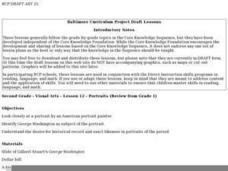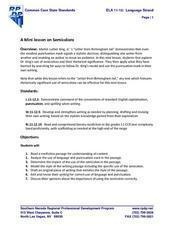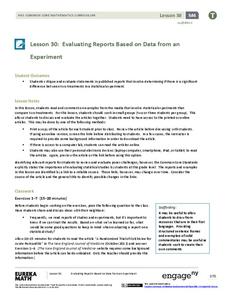Curated OER
Hazelwood v. Kuhlmeier
Students read the case text of the Hazelwood v. Kuhlmeier case. Using the text, they discuss the case history and the implications of the verdict. They share their findings with the class in the form of a PowerPoint presentation and...
Curated OER
"Kokoro (True Heart)" by Velina Hasu Houston
Students read and analyze a play that examines a cultural defense case. They analyze case studies, formulate an argument, write about the Japanese Festival of the Dead, and answer discussion questions about the play.
Curated OER
Tomato Exploration
Create tomatoes in 15-20 minutes using this fun and interactive lesson plan! Learners listen to a book about tomatoes (recommendations listed), and focus on the vocabulary word tomato. They count the syllables...
Curated OER
Farm Animals
Why are farm animals important to the community? Expand young farmers' knowledge of furry and feathered friends through stories and a video. There are several books recommended; however, you could use any book about farm animals. A video...
Curated OER
Civil War Soldiers
High schoolers investigate the concept of having a draft for obtaining military forces. They conduct research in small groups using a variety of resources in order to answer key questions. The ideas of having a volunteer army instead is...
Curated OER
Visual Arts: Portraits
Second graders examine a portrait of George Washington, and analyze the historical record and likeness in portraits of the period. They create their own portraits from snapshots brought to school.
Curated OER
Philadelphia's Important Contribution to the Lewis and Clark Expedition
Students analyze a primary source document (Jefferson's secret letter to Congress) and identify its objectives through the aid of focus questions. They complete a graphic organizer and write an article summarizing Philadelphia's...
Curated OER
Ticket to Ride
Consider the images, ideas and words connected with America with your class as they design a new American passport for the 21st century that reflects an individual vision of and for America. Students reflect on the image of America...
Curated OER
"C" Unit
Explore the letter C and the concept of courage with your class. In this religious lesson plan, learners are introduced to the concept of courage through stories from the Bible and then have a variety of multi-disciplinary activities...
Curated OER
"Bats on Parade" by Kathy Appelt
Middle schoolers examine numbers and try to find a pattern in their relationship. They write an algebraic expression for the nth term.
Curated OER
A Trip Down Memory Lane- Memoir Lesson Plans
By teaching memoir lesson plans, teachers can help students expand their awareness of different languages and cultures.
Curated OER
Eugenics Worksheet
Students become familiar with the vocabulary associated with treatment of disabilities. In this Eugenics lesson, students complete a worksheet on Eugenics and discuss the treatment of people with disabilities in the past and present.
Curated OER
Teach Inferences in a Systematic and Engaging Way
Benefit from specially designed materials to help you teach inference in a systematic and rewarding way!
US Holocaust Museum
Deconstrucing the Familiar
Collaboration and complicity. Class members examine a series of photographs and consider how active participation and passive complicity represented in the photos contributed to the Holocaust.
Southern Nevada Regional Professional Development Program
A Mini lesson on Semicolons
Dr. Martin Luther King, Jr.'s "Letter from Birmingham Jail" serves as an exemplar for a mini-lesson on semicolons. Working alone or in small groups, class members first circle all the semicolons in the letter, and then consider how this...
EngageNY
Replacing Letters with Numbers II
Teach about properties properly. Individuals investigate the commutative and identity properties for both addition and multiplication. They see that the properties hold true for all values by using substitution to test out several examples.
EngageNY
Modeling an Invasive Species Population
Context makes everything better! Groups use real data to create models and make predictions. Classmates compare an exponential model to a linear model, then consider the real-life implications.
EngageNY
Evaluating Reports Based on Data from an Experiment
They say you can interpret statistics to say what you want them to. Teach your classes to recognize valid experimental results! Pupils analyze experiments and identify flaws in design or statistics.
Star Wars in the Classroom
"Shakespeare and Star Wars": Lesson Plan Day 6
How can a screenplay create meaning and drama in ways that other forms of writing cannot? That is the question class members must answer as they compare the cantina scene of the screenplay for George Lucas's Star Wars: A New Hope...
Curated OER
Doyle Online Writing Lab: Paper Editing Worksheet
Both the writer and the reviewer contribute to this editing worksheet. Before handing the paper to a partner, the writer lists specific areas of concern for the reader to address. The editor addresses these concerns and offers detailed...
EngageNY
Putting It All Together
Shuffle 'em up and deal! Learners practice operations with polynomials using cards they pass around the room. The activity works with pairs or individuals, so it offers great flexibility. This is the fifth installment in a series of 42...
EngageNY
Drawing a Conclusion from an Experiment (part 2)
Communicating results is just as important as getting results! Learners create a poster to highlight their findings in the experiment conducted in the previous lesson in a 30-part series. The resource provides specific criteria and...
EngageNY
Increasing and Decreasing Functions 2
Explore linear and nonlinear models to help your class build their function skills. In a continuation of the previous lesson, learners continue to analyze and sketch functions that model real-world situations. They progress from linear...
EngageNY
Posing Statistical Questions
Is this a statistical question? The opening lesson in a series of 22 introduces the concept of statistical questions. Class members discuss different questions and determine whether they are statistical or not, then they sort the data...























